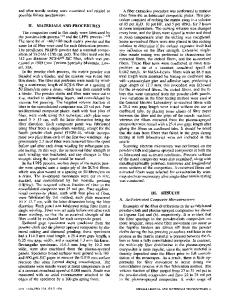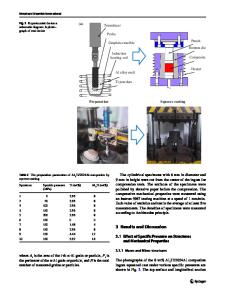Improvement of Mechanical Properties in the Functionally Graded Aluminum Matrix Nanocomposites Fabricated via a Novel Mu
- PDF / 3,179,783 Bytes
- 10 Pages / 593.972 x 792 pts Page_size
- 66 Downloads / 346 Views
I.
INTRODUCTION
FUNCTIONALLY graded materials (FGMs) are one of the most promising candidates among advanced materials recognized by its compositional gradient at least in one direction.[1] The graded structures are beneficial for different applications, especially when a high-toughness bulk material with an excellent surface wear resistance is required.[2] Numerous literatures pointed out that the further improvement will be achieved in properties of FGMs as a result of reduction in reinforcement particles size to nanometric scale.[3,4] The fabrication techniques of functionally graded particulate composites are classified into liquid phase and powder metallurgy techniques.[5] The liquid phase techniques are highly affected by the occurrence of particles’ movement in the liquid slurry, agglomeration, and interfacial reaction between the nano-sized particles and molten matrix.[6,7] Furthermore, obtaining a dense bulk material via powder metallurgy methods is costly, time and energy consuming.[8] Friction stir processing (FSP) is a solid state technique developed based on the principles of friction stir welding (FSW).[9] In FSP, a rotating tool with a particular geometry of pin and shoulder is plunged into
MOJTABA SALEHI and ARASH HEYDARIAN, MSc Graduates, and JAMSHID AGHAZADEH MOHANDESI, Professor, are with the Department of Mining and Metallurgical Engineering, Amirkabir University of Technology, P.O. Box 15875-4413, Tehran, Iran. Contact e-mail: [email protected] HAMIDREZA FARNOUSH, Assistant Professor, is with the Department of Metallurgy and Materials Engineering, Faculty of Engineering, University of Kashan, P.O. Box 87317-51167, Kashan, Iran. METALLURGICAL AND MATERIALS TRANSACTIONS B
a single piece of material and traversed along it. The frictional heat softens the matrix, and the reinforcing particles can be incorporated in the plasticized matrix due to the intense stirring action of the tool. Mishra et al.[10] first reported the fabrication of composite by utilizing FSP. Since then, FSP has been applied extensively in fabricating of nanocomposite with various matrix alloys such as aluminum,[11–13] magnesium,[14,15] and titanium alloys,[16] although there are only a very few attempts on the production of graded structures via FSP. For instance, Hanagai et al.[17] managed to produce functionally graded aluminum foams by changing the porosity percentage along the specimen’s height. A preliminary research on the fabrication of aluminumbased FGMs was conducted by Garanda et al.[18] Also, different strategies have been introduced by Miranda et al.[19] They used a simple pre-deposition of particles on the top surface of workpiece followed by FSP and also, utilized a consumable aluminum tool with drilled hole filled with reinforcing particles. However, to the authors’ best knowledge, there is no through work reporting the mechanical behavior of bulk FGM by FSP. Although some attempts have been made to fabricate FGMs via FSP, more efforts should be made in order to overcome problems such as particle heterogeneity and lo
Data Loading...











